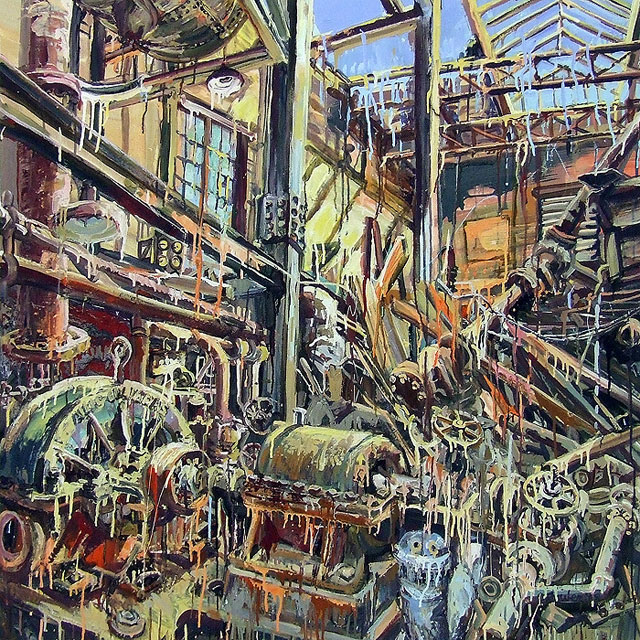
Cindy Tower Allis Chalmers 2008 Oil and enamel on canvas 48×48 inches
This week I’m posting yet another extreme in perceptual painting – this time on the opposite end of the spectrum from my previous post on David Ligare Classism which is Cindy Tower’s blend of performance art, post-modernism and neo-expressionist ashcan school plein air painting! Cindy Tower has been painting her “workplace series” since 2005 in abandoned East St Louis industrial sites. She shows at the Bruno David Gallery in St Louis. Previously in the 80’s and 90’s she was known as a performance and installation artist in NYC. She had worked for several years as an assistant to Red Grooms. In around 2000 she decided to turn to painting – many from life. In an Feb 2008 article in the Riverfront Times.com she states, “I felt like a performing monkey entertaining all these rich people, making these experiences,” says Tower. “I was also so tired of cynical, sarcastic artwork. Glibness bores the shit out of me. I’m not interested in it. It’s just like coming on a canvas. To be rebellious now is to have integrity and shoot from the hip and speak from the heart. That’s how you really freak out people, because that’s completely not where the art world’s values have gone.”
First of all I am a big fan of urban explorers and her stealth gorilla style plein air painting in the visually and historically rich rust belt ruins strikes me as a tremendously exciting activity, I want her to succeed. (A side note, I once made a couple of paintings in an abandoned state mental hospital so I have a big soft spot here) This type of painting is not for the faint of heart. Even “Plain Jane” plein air painting can pump up your adrenaline by just chasing the light on a pastoral scene but also worrying about your immediate safety can make for some edgy painting. The huge scale of many of these works (up to 90 x 70 inches) also makes her a highly visible target. She addresses this concern by bringing mace, a trusty aging beagle, a elderly bodyguard armed with a golf club and for extra protection, a homemade bodyguard made from cushions.
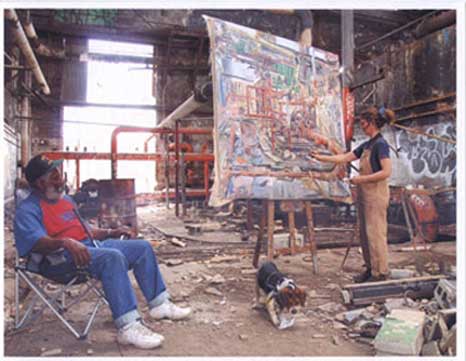
In her artist statement Cindy says; “…It is almost as if paintings have become props for real-life experiences. I trespass a lot; deal with weather, season, time, wild dogs, crack addicts and homeless residents. Sometimes I paint with a hard-hat if sites are condemned and bricks are falling. In the winter I have to heat up coco and eat hot dogs cooked on a 55-gallon drum to keep warm. I hoist a 25-foot-high extension ladder to get into some ruins and daily hide and camouflage my paintings because they are too big and wet to transport back home each night.”
She paints in a direct, loose manner that strives to connect with what she finds here. Her involvement with the site influence her in other ways as when she says; “This year my painting style has changed. I’ve switched mediums (from working with artist-grade oil paint to left-over, industrial-grade paint salvaged from dumpsters) and am applying paint more loosely. To me, the melting of painting surfaces mirrors that of the economy’s deterioration. I feel as though I am painting the actual recession.”
As much as I want to like her work I tend to cringe over statements like this. These paintings don’t work for me anymore as social commentary than as great painting but her riveting tales of danger and performance in factory ruins do make them attention getting. She appears to have an intense personal identification with these ruins, perhaps it’s the thrill of adventure and of being a part of something real enough to kill you.
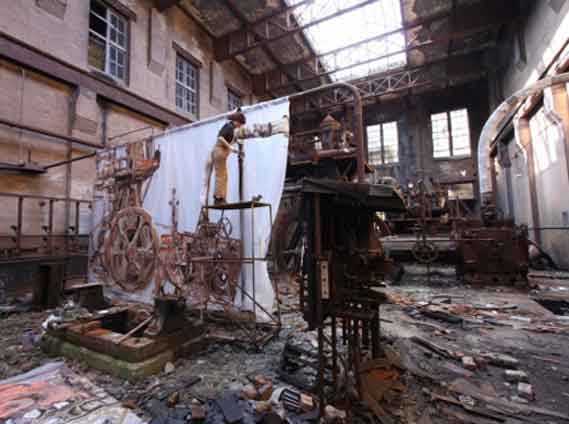
Many times today the critical success of the painting has to do with how clever the idea behind the work is rather than what we actually see before us. To my eye these paintings suffer from not being drawn and painted well enough; the space is airless and unconvincing, the color seems casual and unresolved, the busy work of obsessive details keeps one from seeing the painting as unified whole.
She doesn’t seem to really be looking carefully enough at these ruins. I would love to see her truly paint what she is actually looking at, the exact color of the light hitting the rusted metal and broken glass could be shear poetry, that you could actually move through the space in the painting as you do in these magnificent ruins. But she settles for cartoon-like simplification and drawing shortcuts that expresses an idea of the place but lacks true form.
But I am looking at her work from the point of view of painters who firmly believe in the long traditions of painting and see realist painting as a vital living art that speaks to today’s world as much as the past. I don’t believe there are dual standards in paintings – one for those who know how to paint and another for those that don’t. I can’t think of a good way to sugar coat it, she needs to put in her time in learning her craft more.
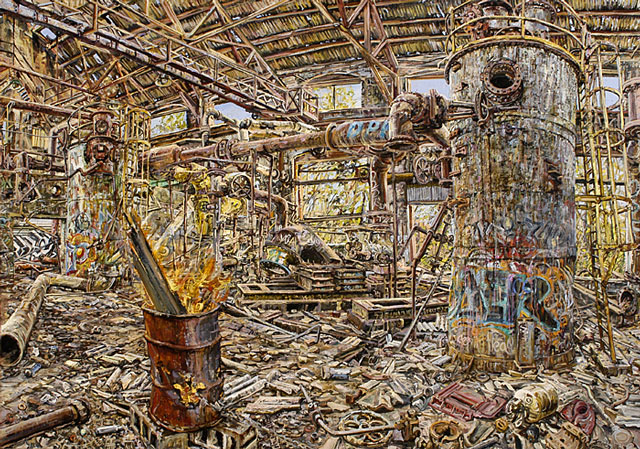
My Brothers and Myself, 2007 oil 60 x 84 inches
She undoubtedly would disagree and operates with a completely different set of rules and beliefs. She states in her artist statement: “Consumption, intimacy, obsolescence, loss, and transcendence, the paintings are an overwhelming celebration of materials and process. They hope to provide the viewer with a visceral, physical experience that not only engages but also actually engulfs the viewer in the self-contained environment of each work of art. Paintings become installations, and I am a performer.”
She also stated in her video. “I have an anti-aesthetic sensibility, I believe in chance, circumstance and chaos, I believe nature itself is organized, any mark I plant is a mistake but the great mystery is that it all pulls together to form a whole painting.” This strikes me as the words of someone who has “gone native” – like war journalists joining up with the rebels, clouding their judgment and causing their reporting to be suspect. Putting all your faith in nature and turning your back on art is naive. She is right to say her paintings are installations and she is a performer which is too bad because she has a great idea for some real painting.
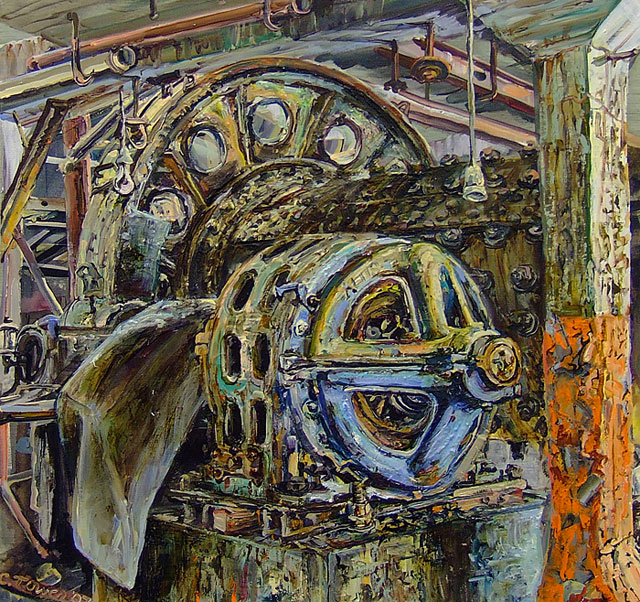
My Little Brother, 2007 28 x 29 Oil on fabric





Fantastic! Wonderful! Thank you!!!! A perfect antedote for the last painter you presented.
Am I in love with her surfaces? No…. nor am I in love with her sloppiness in dripping paint, or her obiviously incorrect color choices… But, when I look really closely at these, her perspective is spot-on, and the amazing amount of accuracy she gives , or is able to suggest in the complicated machinery she paints is (as I guess I’ve already stated) fantastic.
Now I agree entirely with your feelings about her work, Larry… but that is because I myself, fall somewhat in the middle between this painter and the last one, and, from seeing the work you have presented that you do, I’d say you fall in somewhat the same place.
The question of the amount of attention an artist pays to the naturalness and “correctness” of their subject, is something I believe is strictly up to temperament. I don’t think I could paint “sloppy”, anymore than this artist could paint finer surfaces. It’s not a question of paying more attention to what she sees, it’s obivious to me she is paying as much as is necessary FOR HER, for the sorts of works she envisions.
Her statement: “To be rebellious now is to have integrity and shoot from the hip and speak from the heart. That’s how you really freak out people, because that’s completely not where the art world’s values have gone.” couldn’t be something I could agree with more. I think she has captured the contemporary scene totally, so I think she knows exactly where she’s coming from and where she’s headed.
A couple of side-points: I can’t remember an Ash Can school painting that wasn’t all about the people in it. Tower has consciously left her paintings un-peopled.
As a painter who is drawn to these sorts of enviroments for subject matter, I can only tell you the danger IS real, but add one extra one for the West Coast: HomeLand Security, whose path I have crossed twice, and who, I can tell you first hand, are no fun to deal with.
For an interesting take on this same type of subject matter, find a repro of Sir William Russell Flint’s Diploma painting, from back when he should have been the finest water-colourist since Sargent. Flint got permission to paint inside a British Naval ship building facility during the war. He had 1 afternoon only, and what came out would fulfill every thing you’ve stated you look for in a work of this sort.
Glad you found this post interesting William. I am starting to wonder if I should have held back on the criticism and just showed the work like I usually do. I don’t like to really judge work that I haven’t actually seen in person as I think it’s important to actually see the scale, surface and the color – which is often lost in a little jpeg. But something about her and her work made me respond more viscerally than I usually do. Even though I dissed her drawing and painting chops a bit I do really like the energy in her paintings, Some of them are truly wonderful I just want them to be even better. which to me means a more probing exploration in painting what she is looking at.
When I talk about the space not working for me I am not referring to the perspective (although I can see problems with that too in places) I mean more how the overall form of the large interior would clearly read from foreground to background, that you are able to feel where things sit in space and that everything isn’t just on the surface.
Of course she can do whatever the hell she wants, fine by me but I think the neo-expressionist type primitive style she holds on to here holds her back more than helps her. If she truly wants to let go of all the arty, glib and cynical trendyness and truly paint from her heart the I would suggest she would be better off trying to paint this stuff with as much humbleness and honesty as she can.
I just threw the “ashcan” in there – I don’t think she ever used that word. (she did paint a rather nice painting of her bodyguard though) I didn’t know her teachers in her MFA program, those faculty members at UCSD you mention but I’ve met the type before, makes me sick just thinking about it.
As Wm. Dubin commented that’s a heck of a contrast to the previous post on Ligare.
I’ve often wondered about the dilemma of much performance art that she hints at in her comment- “I felt like a performing monkey entertaining all these rich people, making these experiences,” says Tower.
Thanks again Larry for providing such unexpected material.
Thanks Philip, Sorry I don’t always get to respond to all the comments right away. Glad you liked the post.
I rather like Ligare’s work. I have a deep love and respect for Poussin, even went to NYC to the Met’s big Poussin Landscape show a couple of years ago. I know I would never paint like Ligare or Poussin myself but I respect there art none the less. I’m not sure what to say about performing monkey’s in front of rich people except perhaps she is still performing – just a different set. Sadly, it’s usually just the rich people buying and looking at art so we all need to come to terms with it somehow.
Philip,
As she comments in her video, Tower studied (?) with Eleanore Antin at SD State. Not certain if you know who she is (or Larry, for that matter). I lived in SD for many years, and although I never met Antin, I knew about her, and Art Forum from that time was very big on her and her husband. Their hated of any form of painting was well known.
Once you know this, the fact that Tower did Performance stuff (sorry, I can’t think of that crap as art), makes total sense, and the fact that she was able to get past it is like breaking an addiction…. on this level, I can forgive her a lot.
Glad that you’ve presented such different painters for us to consider. Ligare’s pictures are the type that inspire some respect for technique and doggedness while revealing little about lived experience as I perceive it. Their frozenness reminds more of photography than first-hand experience, their elegance some classicizing ideal quite alien to my particular temperament…Tower’s pictures hit closer to home for their sloppiness and general disorder. It’s much closer to the world I know, but her seeming lack of interest in locating any specific light source or any discernable hierarchy between objects leaves me wanting more than she gives. Her stated aims indeed seem more challenging and diverting than his, but by presenting one after the other, you’ve given us some small inkling of the range possible in perceptual painting…
Good points Dmitry, Like I said I respect Ligare’s work and the way he brings modern life to classicism, unlike many others working in a similar neoclassical style but I agree that Tower speaks to me more directly – even if I do find her painting chops wanting. I am starting to regret giving her such a hard time!
Larry,
For what its worth, I personally think it gives us (me at least) something more, that you’ve reacted to Towers work. After all, it is your Blog, and while your choices tell a lot, your judgements do also. I understand your not doing this in most cases, still, when I go back through your posts, I find you’ve commented quite a bit, just not so negatively. But that’s fine…. just gives us (me) more to bounce off of.
Poussin was a very important painter and influence. I can both understand and appreciate what he did and what came after because of him… I feel the same about Ingres, whose drawings may never be surpassed for what they are.
But personally, as a painter working in THIS TIME, I feel far more in line with those painters who reacted to the Classicism of the two above, just as I do Tower rather than Ligare. Both are necessary in a healthy art enviroment.
I agree with you, that Tower is still working through (or using) her art-speak College crap….. she hasn’t yet realized she can just DO the work and forget the justifications. But you know, that’s what the art critics, the magazines, the gallery owners, and the “patrons” want to hear! That’s why you learn it in art school… its become as necessary as the art itself, in some cases, it makes up totally for the art itself.
I started to realize my work was getting good when I realized I was running out of words about it.
The fact that you took time to criticize her work means it was worthwhile enough to consider. So much that’s out there doesn’t rate more than a passing glance. I wouldn’t feel bad about it as you’re giving Ms.Tower attention and any painter out there should be grateful for that…As to Ligare, I’ll agree that his isn’t the most stillborn work of that ilk that can be found. Sure that the warehouses for places like Forum Gallery are filled with long-forgotten bacchanales, as well as, various and sundry historical and mythological chefs-d’oeuvres…
This painter does seem to have schtick that is attractive in certain ways. Working in scary environs has never helped my painting. Its difficult to concentrate if tractor-trailer trucks rush by and kick up dirt into your painting but sometimes you have to endure it if what you want to paint puts you on the side of the highway.
Bringing a body-guard seems to be taking it a bit far.
The works themselves? They’d probably seem enticing if seen in life. Tough to say based on jpegs. I’m sure they’re all about painting surface. The color seems chalky.
The moment you set up in an urban enviroment you are running a certain risk. Tower seems to add to this by placing herself inside buildings which are self-destructing, and could easily fall while she is there. It seems stupid on the face of it, but, it’s the only place you can find this sort of industry and the machines that propelled it. Like everything else, you have to go where the subject is.
Her body guard looks far more like an elderly companion than a “bouncer”, he doesn’t look like he could do much against an urban gang, so I think her calling attention to him is more the creation of her own myth than anything else. There is also the unstated relationship to paintings such as Sargents portrait of Monet painting, with Monet’s wife sitting in the background, and photo’s of Sargent on location with his group of friends watching while he works…. All this, I feel is Tower performing still, and creating her myth.
But remove all this from the works themselves, and what you’ve got is the energy and the sheer audacity of painting in this fashion…. which, for “realism” today, is, I feel, a nice addition, and something somewhat unique to her work.
Again, I’m not personally excited by the surfaces, but they seem to be the price you pay to get the paintings.
With regards to her opposite number, Ligare, I came across a very instructive photo of a painting in the Whitney Museum collection by Charles Scheeler, done in 1932……. nearly identical to Ligare’s Landscape (minus the Ekins rower, that is)…… it kind of put a further kink in his work for me.
Keep dancing your dance, Cindy, and every good wish!